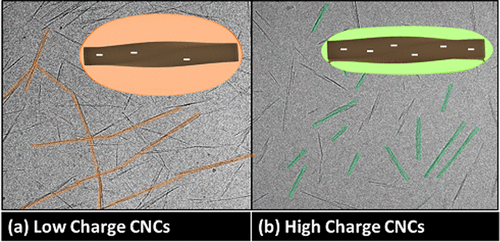Our official English website, www.x-mol.net, welcomes your
feedback! (Note: you will need to create a separate account there.)
Surface Charge Influence on the Phase Separation and Viscosity of Cellulose Nanocrystals
Langmuir ( IF 3.7 ) Pub Date : 2018-03-07 00:00:00 , DOI: 10.1021/acs.langmuir.7b04127 Tiffany Abitbol 1, 2 , Doron Kam 1 , Yael Levi-Kalisman 3 , Derek G. Gray 4 , Oded Shoseyov 1
Langmuir ( IF 3.7 ) Pub Date : 2018-03-07 00:00:00 , DOI: 10.1021/acs.langmuir.7b04127 Tiffany Abitbol 1, 2 , Doron Kam 1 , Yael Levi-Kalisman 3 , Derek G. Gray 4 , Oded Shoseyov 1
Affiliation

|
A series of four cellulose nanocrystal (CNC) suspensions were prepared from bleached softwood kraft pulp using different conditions of sulfuric acid hydrolysis. The CNCs were identical in size (95 nm in length × 5 nm in width) but had different surface charges corresponding to the harshness of the hydrolysis conditions. Consequently, it was possible to isolate the effects of surface charge on the self-assembly and viscosity of the CNC suspensions across surface charges ranging from 0.27%S to 0.89%S. The four suspensions (never-dried, free of added electrolyte) all underwent liquid crystalline phase separation, but the concentration onset for the emergence of the chiral nematic phase shifted to higher values with increasing surface charge. Similarly, suspension viscosity was also influenced by surface charge, with suspensions of lower surface charge CNCs more viscous and tending to gel at lower concentrations. The properties of the suspensions were interpreted in terms of the increase in effective diameter of the nanocrystals due to the surface electrostatic repulsion of the negative sulfate half-esters, as modified by the screening effects of the H+ counterions in the suspensions. The results suggest that there is a threshold surface charge density (∼0.3%S) above which effective volume considerations are dominant across the concentration range relevant to liquid crystalline phase formation. Above this threshold value, phase separation occurs at the same effective volume fraction of CNCs (∼10 vol %), with a corresponding increase in critical concentration due to the decrease in effective diameter that occurs with increasing surface charge. Below or near this threshold value, the formation of end-to-end aggregates may favor gelation and interfere with ordered phase formation.
中文翻译:

表面电荷对纤维素纳米晶体相分离和粘度的影响
使用不同的硫酸水解条件,从漂白的软木牛皮纸浆中制得一系列四个纤维素纳米晶体(CNC)悬浮液。CNC的尺寸相同(长度为95 nm×宽度为5 nm),但具有不同的表面电荷,与水解条件的苛刻程度相对应。因此,可以隔离表面电荷对CNC悬架的自组装和粘度的影响,其范围介于0.27%S至0.89%S的表面电荷之间。四个悬浮液(从未干燥,没有添加的电解质)都经历了液晶相分离,但是随着表面电荷的增加,手性向列相出现的浓度开始转移到更高的值。同样,悬浮液粘度也受表面电荷的影响,具有较低表面电荷的悬浮液CNCs更具粘性,并在较低浓度时趋于凝胶化。悬浮液的特性是通过增加纳米晶体的有效直径归因于负硫酸盐半酯的表面静电排斥作用,而悬浮液中的H +抗衡离子的屏蔽作用对此进行了修正。结果表明存在阈值表面电荷密度(〜0.3%S),高于该阈值时,在与液晶相形成有关的整个浓度范围内,有效体积的考虑因素占主导地位。高于该阈值,相分离发生在相同的CNC有效体积分数(〜10 vol%)下,由于随着表面电荷的增加有效直径的减小,临界浓度也相应增加。低于或接近此阈值,端到端聚集体的形成可能有利于胶凝并干扰有序相的形成。
更新日期:2018-03-07
中文翻译:

表面电荷对纤维素纳米晶体相分离和粘度的影响
使用不同的硫酸水解条件,从漂白的软木牛皮纸浆中制得一系列四个纤维素纳米晶体(CNC)悬浮液。CNC的尺寸相同(长度为95 nm×宽度为5 nm),但具有不同的表面电荷,与水解条件的苛刻程度相对应。因此,可以隔离表面电荷对CNC悬架的自组装和粘度的影响,其范围介于0.27%S至0.89%S的表面电荷之间。四个悬浮液(从未干燥,没有添加的电解质)都经历了液晶相分离,但是随着表面电荷的增加,手性向列相出现的浓度开始转移到更高的值。同样,悬浮液粘度也受表面电荷的影响,具有较低表面电荷的悬浮液CNCs更具粘性,并在较低浓度时趋于凝胶化。悬浮液的特性是通过增加纳米晶体的有效直径归因于负硫酸盐半酯的表面静电排斥作用,而悬浮液中的H +抗衡离子的屏蔽作用对此进行了修正。结果表明存在阈值表面电荷密度(〜0.3%S),高于该阈值时,在与液晶相形成有关的整个浓度范围内,有效体积的考虑因素占主导地位。高于该阈值,相分离发生在相同的CNC有效体积分数(〜10 vol%)下,由于随着表面电荷的增加有效直径的减小,临界浓度也相应增加。低于或接近此阈值,端到端聚集体的形成可能有利于胶凝并干扰有序相的形成。











































 京公网安备 11010802027423号
京公网安备 11010802027423号